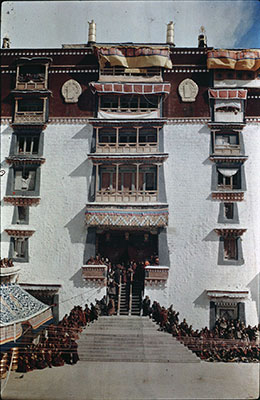
1998.157.76 (Transparency colour)


1998.157.76 (Transparency colour)

Frederick Spencer Chapman
Frederick Spencer Chapman
February 10th 1937
Lhasa > Potala > Deyang shar
1998.157.76
90 x 60
Transparency Colour
Donated 1994
Faith Spencer Chapman
British Diplomatic Mission to Lhasa 1936-37
Frederick Spencer Chapman
SC.T.1.76
In Negative - '2 LSCT 667/24 3 1/8 X 5' has been written on the reverse right hand side of the transparency in pencil [MS 07/04/2006]
Technical Information - This transparency has been produced in reverse and needs to be flipped to see it the right way round [MS 07/04/2006]
Exhibition - This image appeared in the 2003 Temporary Exhibition at the Pitt Rivers "Seeing Lhasa: British Depictions of the Tibetan Capital 1936-1947"
Other Information - Cultural Background: The “Tse Gutor” masked dance ceremony takes place at the end of the Tibetan calendar and is designed to purge the sins of the past year. At the Potala it is performed by the monks of Namgye Tratsang who undergo training for many years. Richardson gives a detailed account of this event in “Ceremonies of the Lhasa Year”: “The chief is the Chinese priest Hashang, a huge heavily padded figure in a scarlet robe and with a massive, smiling bald-headed mask. With him are two tiny child-like figures, two more in the dress of Indian sadhus, and two with death’s head masks” (1993:116 – 123) Then two more masked dancers arrive - one representing Shinje the lord of the dead and protector of the Buddhist faith and the other, the stag-headed Tsamuntri. Other dancers portray wrathful protector deities such as Dorje Jigje (with a bull’s head), Tamdrin (the horse-headed), a red masked Mahakala and the black-faced Lhamo. [CH 2003]
Other Information - Description: Entry in Mission Diary for February 10th 1936: "Today we were invited by the Tibetan Government to witness the first of the ceremonies connected with the Tibetan New Year. // With sound reasoning the Tibetans hold that before you can hope to celebrate and [ sic ] auspicious New Year, all the evil influences which have accumulated during the Old Year must be driven out. Accordingly on the 29th day of the last month a devil dance takes place in the great Eastern Court of the Potala. // All officials from the Regent down are present, those of the higher ranks in the rooms in the high Western facade above the triple steps which lead down into the court. // The red, black, and yellow pelmets over the windows flap and belly in the chilly north wind" ['Lhasa Mission, 1936: Diary of Events', Part XIV pp. 1-2, written by Richardson] [MS 04/04/2006]
Other Information - Location: This photograph seems to have been taken at the entrance to the eastern courtyard, before the Mission party moved to their official location for the occasion in the balcony above [see ['Lhasa: The Holy City', F. Spencer Chapman, London: Chatto & Windus, 1938, p. 301] [MS 06/04/2006]
For Citation use:
The Tibet Album.
"Waiting for Tse Gutor ceremony"
05 Dec. 2006. The Pitt Rivers Museum.
<http://tibet.prm.ox.ac.uk/photo_1998.157.76.html>.
For more information about photographic usage or to order prints, please visit the The Pitt Rivers Museum.
© The Pitt Rivers Museum